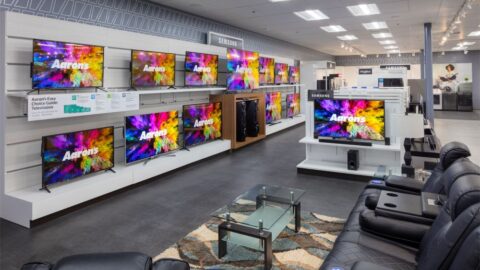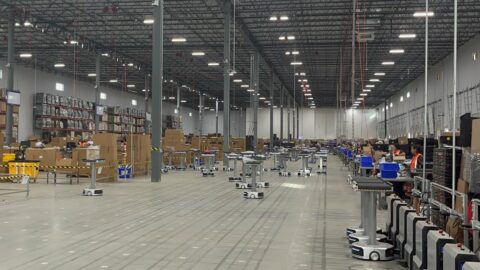In yet another sign that the COVID-generated ecommerce surge has subsided, the Salesforce Shopping Index reported flat ecommerce sales in the U.S. for Q1 2023 — the first period with no online sales growth since the Index debuted in 2014. The U.S. pullback in online spending contributed to a 2% year-over-year drop globally, although growth rates remained higher in smaller markets like the Middle East and Africa, at 21%, and in Latin America, which saw 7% growth.
“If you were drawing a trends graph, it would show a massive spike in everything digital and online during COVID that plummeted post-pandemic and then renormalized,” said Michael Affronti, the recently appointed GM of Commerce Cloud at Salesforce in an interview with Retail TouchPoints. He added that for Q1 of this year, “conversion and basket sizes are down, and we see that fairly consistently across our customer base.”
While this data doesn’t paint a particularly cheerful picture — and it’s certainly alarming for digital-only players — it’s not all doom and gloom. Affronti identified several paths retailers can take to ride out a challenging year, and even to find areas for growth:
- Since loyal customers are sticking with brands they know and trust, retailers should do everything they can to retain and nurture these consumers;
- Conversational commerce via channels like WhatsApp and WeChat give retailers new opportunities to meet customers where they are and complete transactions by removing friction at key points; and
- Exploring the possibilities of generative AI to augment personalization efforts.
Retail TouchPoints (RTP): What can retailers do to deal with the challenge of slower online sales?
Michael Affronti: For the merchants we service with Commerce Cloud, there’s not much we can do to change the macro trends quickly, but at the forefront of every conversation we have with our customers we’re saying that while a lot of the data shows that disposable income going down [due to inflation] means customers spend less, for brands they know and trust [spending] won’t go down as much.
There was a surge in DTC and pop-up brands over the last few years, especially with the rise of social shopping, that gave birth to a whole set of choices, but customers generally are loyal to brands that have served them well and have good quality products. So the questions retailers should be asking themselves are: How loyal are your customers? What are you doing to nurture them? And how are you giving them a value-added product or service for being loyal to you? That [retailer-loyal customer] interchange has never been stronger.
In one sense what we’re seeing is a shift of business to different places, and a cross between physical and digital, rather than a decline. For example, one retailer we work with that has a large store footprint has seen a 2X increase in buy online, pick up in-store [BOPIS] compared to before the pandemic. Retailers need to ask what people are using their storefronts for, track where the conversions are happening and give people a good reason to come back.
RTP: What are some ways retailers can take advantage of the changes that COVID accelerated?
Affronti: This is one case where a global perspective can be informative. Our customer base is multinational and also includes companies that exist wholly outside the U.S. One big thing we’re seeing is the rise of conversational commerce, with interactions that are completely within a conversational interface. That could be a bot that the brand has put forward to interact with you, or [a consumer] scanning a QR code in a retail store to begin a loyalty journey that happens over WhatsApp and continues after you leave the store.
For example, I was recently traveling in Latin America and the hotel asked me to scan a QR code, and then a WhatsApp bot took over after I checked in. I interacted with it to do things like request more towels, and then it switched into a nurture campaign, providing offers to encourage me to come back to the chain’s hotels.
That’s part of the very fast-moving trend toward meeting customers where they are, and that’s often in a conversational interface. Being able to get a promotion saying, “Here’s 10% off if you book your next trip with us,” and the offer is only good for two hours — the ability to do that quickly, and in the moment, in the chat, is very important.
Another opportunity is for field service technicians and reps that now have upsell opportunities that they [can complete] with customers in person. Previously, companies may have relied on [the customer] getting a follow-up email [as the way to continue the engagement]. So the question becomes, how do we make the person in the field able to swipe the credit card, or tap-to-pay in the moment, to complete the transaction? Retailers have to offer the full spectrum of both commerce and conversion anywhere that they are talking to the customer.
RTP: What are some specific ways retailers can remove friction, particularly in these self-service or remote interactions?
Affronti: Based on our research and customer feedback, we’re seeing that consumers today are way more open to, for example, scanning a QR code at the table at a restaurant, or having a brand save their credentials in the app or on the brand’s site. In general the [consumer’s] expectation is that you’re up to snuff security-wise, and the value that’s being provided is so high that it creates a virtuous cycle. And at a very practical level, if the field service tech has [a customer’s] preferred payment method saved and available, because they have access to the customer’s info, the conversion rate is higher.
The tech to do that now is available securely, and [customers] trust that you can save their credentials safely. Creating that kind of virtuous cycle required that all these different pieces be available, so it’s been a combination of consumer demand, tech developments and the pandemic impact of frictionless payment and conversion.
RTP: What impact can the latest iterations of AI play in managing customer engagement during volatile times like now?
Affronti: At Salesforce we’ve been using AI to support digital merchants, especially via Commerce Cloud, for over a decade. This has been the more recommendation-style AI, things like “Here’s what you need to complete the set” or offering the next best product recommendation, which can help drive incremental value and loyalty.
Today, one thing we’re thinking deeply about is that when you’re talking to a customer about a product, perhaps explaining it to them over a chat, you want it to be as applicable to [that person] as possible. Generative AI can help with content creation that can be augmented with real-time personalization information, so that the retailer can help explain the product in a way that better fits what the customer is looking for.
For example, say the customer’s use case is “I want to go camping.” Any digital merchant offering multiple goods that complete such a use case — like an outdoor clothing retailer that also sells hiking boots and canoes — could give recommendations more holistically by using generative AI to accelerate that experience. The retailer can do merchandising personalization at a scale that’s physically not possible unless they hired 10,000 copywriters, and produce better conversion rates and happier and more loyal customers overall. Essentially, the retailer can operate with the same number of people and produce a better experience for the customer.
It’s about making every moment a transactable moment, and making it as personalized as possible.















